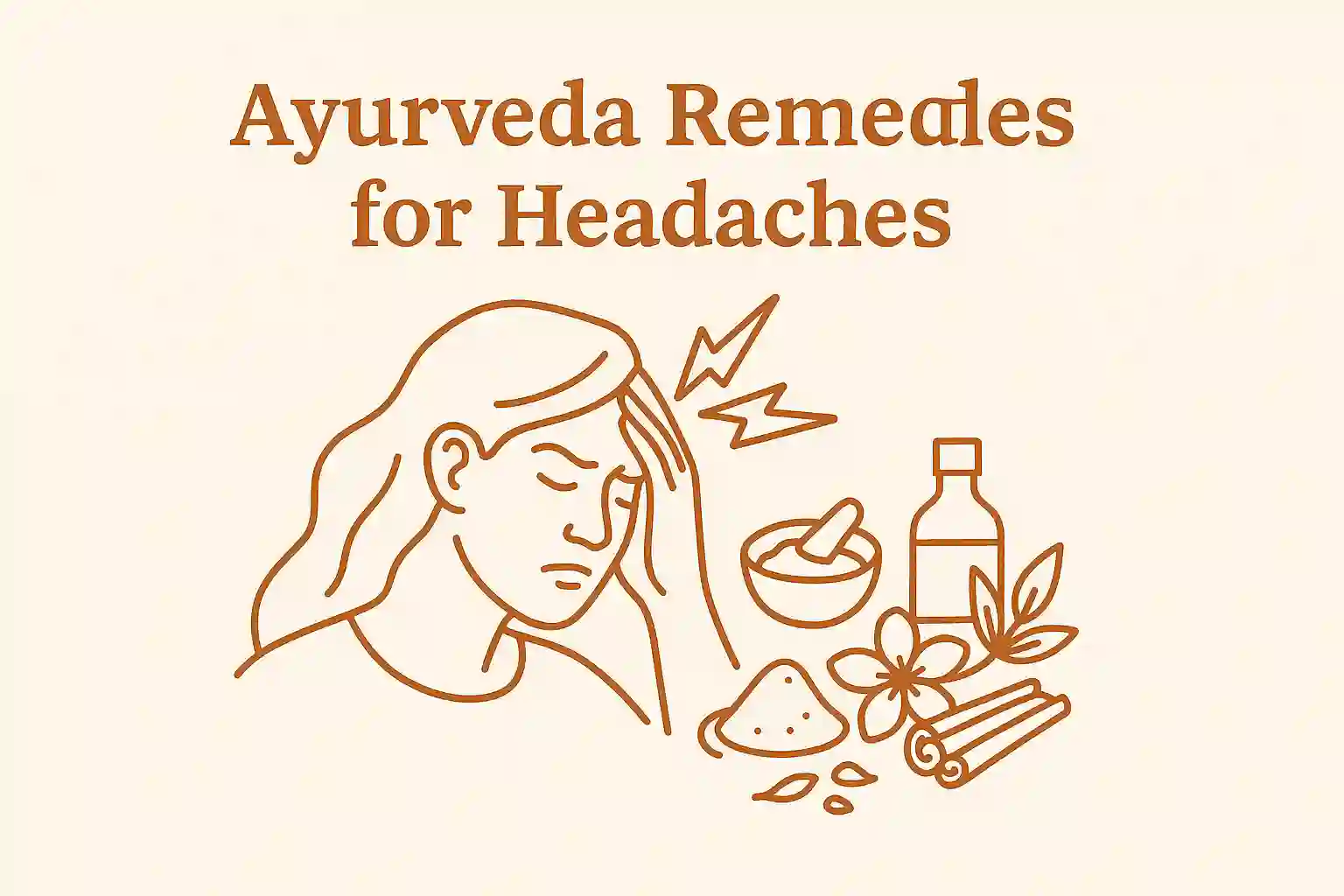Headaches affect millions worldwide, but Ayurveda—India's ancient holistic healing system—offers remedies that go beyond masking the pain. Instead, it aims to identify and correct the root imbalance in the body and mind.
From the Ayurvedic perspective, most headaches stem from an imbalance in the doshas—Vata, Pitta, or Kapha. Understanding which dosha is aggravated helps guide the right treatment.
Common Causes of Headaches in Ayurveda
According to Ayurveda, headaches (Shirashoola) can arise from various dosha imbalances and lifestyle factors:
Vata Imbalance
- • Irregular sleep patterns
- • Excessive stress
- • Dehydration
- • Fasting or skipping meals
- • Hormonal transitions (menopause)
- • Eye strain from screens
Pitta Imbalance
- • Heat exposure
- • Anger or frustration
- • Spicy, acidic foods
- • Intense mental work
- • Sun exposure
Kapha Imbalance
- • Sinus congestion
- • Cold, damp weather
- • Overeating heavy foods
- • Lack of movement
- • Excessive dairy
Additionally, Agnimandya (poor digestion) can lead to Ama (toxin) buildup, which often manifests as headaches when circulation is compromised.
Ayurvedic Remedies for Headaches
1. Herbal Formulations
For Mental Clarity
Brahmi (Bacopa monnieri) – Calms the mind, supports cognitive balance, and reduces stress-related headaches.
Ashwagandha (Withania somnifera) – Reduces stress and tension that often trigger headaches.
For Digestive Support
Triphala – Improves digestion, detoxifies the body, and prevents Ama formation.
Coriander seed water – Soothes Pitta-related heat headaches and supports cooling.
How to use: Follow a qualified practitioner's guidance for proper dosage and preparation methods.
2. Nasya Therapy (Nasal Oil Application)
This traditional therapy involves applying medicated oils through the nasal passages:
- Use Anu Taila or Shadbindu Taila—warm slightly and instill 2–4 drops in each nostril
- Helps cleanse sinuses, improve oxygen flow, and relieve Kapha-induced sinus headaches
- Best performed in the morning on an empty stomach
3. Hydration with Herbal Infusions
Proper hydration with dosha-specific beverages can prevent and treat headaches:
- CCF Tea (cumin-coriander-fennel) – Balances all doshas and supports digestion
- Rose petal water – Excellent for cooling Pitta-type headaches
- Ginger tea – Stimulates circulation and helps with Vata-type tension headaches
4. Massage & External Therapies
Shiro Abhyanga
Warm sesame or coconut oil scalp massage to calm Vata and improve circulation.
Shirodhara
Continuous pouring of warm medicated oil on the forehead for deep relaxation.
Temple Massage
Gentle massage with peppermint or eucalyptus oil for instant relief.
5. Dietary Adjustments
Eating according to your constitution and current imbalance is crucial for preventing headaches:
| Dosha Type | Recommended Foods | Foods to Avoid |
|---|---|---|
| Vata Headaches | Warm, grounding foods like cooked grains, soups, ghee, warm milk | Cold, dry, raw foods; excessive caffeine; irregular eating |
| Pitta Headaches | Cooling foods like cucumber, melons, coconut water, leafy greens | Spicy, oily, fried, acidic foods; alcohol; excessive heat |
| Kapha Headaches | Light, warm meals; spices like ginger, turmeric; herbal teas | Dairy, heavy sweets, cold foods, overeating |
Learn more about proper food combining and explore optimal food pairings by dosha to support healthy digestion and prevent headache-causing toxin buildup.
6. Yoga & Breathing Practices
Gentle yoga and pranayama can provide immediate and long-term headache relief:
Relaxation Poses
- • Shavasana (Corpse Pose) – Complete relaxation for tension headaches
- • Balasana (Child's Pose) – Relieves stress and relaxes neck muscles
- • Gentle neck rolls – Releases tension in cervical spine
Breathing Techniques
- • Bhramari Pranayama – Humming breath to calm the nervous system
- • Nadi Shodhana – Alternate nostril breathing for balance
- • Deep abdominal breathing – Reduces stress and tension
Prevention Tips in Ayurveda
Preventing headaches through daily routine (Dinacharya) is more effective than treating them after they occur:
- Maintain regular sleep: Go to bed and wake up at consistent times
- Follow the 20-20-20 rule: Every 20 minutes, look at something 20 feet away for 20 seconds
- Practice daily meditation: Even 10 minutes can significantly reduce stress
- Stay hydrated: Drink warm water throughout the day, not just when thirsty
- Strengthen digestion: Eat at regular times and avoid Ama-creating foods
- Seasonal adjustments: Adapt diet and lifestyle to current season
When to Seek Medical Attention
- Sudden onset with severe pain
- Vision changes or visual disturbances
- Fever, neck stiffness, or rash
- Weakness, numbness, or confusion
- Headache after head injury
Frequently Asked Questions
Conclusion
Ayurveda's approach to headaches combines herbal support, dietary wisdom, and mind-body practices to address both symptoms and root causes. By understanding your unique constitution through our Dosha Quiz and working with qualified practitioners, you can develop a personalized protocol for lasting headache relief—naturally and safely.
Remember that consistency is key in Ayurvedic healing. Small, daily practices often provide more benefit than intensive but sporadic treatments. Start with one or two remedies that resonate with your constitution and gradually build a comprehensive approach to headache prevention and management.
Related Articles

The Gunas in Ayurveda: Why Qualities Matter in Food, Mind, and Healing
Learn how Sattva, Rajas & Tamas influence your mind, diet, and healing process. Discover Ayurvedic strategies to restore balance and mental clarity.
min read
